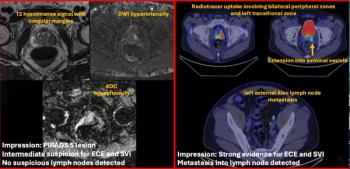
Room for Improvement in Radiology Reports
The radiologist’s most important deliverable is fraught with challenges.
It’s no secret within the industry or health care, as a whole, that the radiology report is the main way you convey your thoughts and diagnosis about a patient’s medical condition and needs. That’s been a radiological truth for more than a century.
But, times are changing – and, according to experts, so are expectations around your most important deliverable.
“The days are numbered when we can simply start with a blank page, pick up a microphone, and tell a story about what we see,” said Curtis Langlotz, MD, PhD, professor of radiology and biomedical informatics at Stanford University. “Referring clinicians, payers, and patients are all demanding higher quality, which requires some degree of consistency and organization.”
These changes are necessary, he said, because current reports make identifying critical information difficult. Your referring physicians are short on time, and succinct reports that follow a consistent pattern will streamline workflow and patient care.
In his latest book,
Until recently, the efficiency and affordability of dictation have been the main reasons behind slow reporting advancements, he said. Now, however, the biggest hurdle is mastering the swiftly-changing technology needed to upgrade and update your reports.
But, overcoming these stumbling blocks is critical, he said, especially in the face of changing payment systems and increasing quality reporting requirements. Your reports must be clear and concise, and they must include clinically meaningful and actionable information.
Ultimately, he said, many radiologists need better guidance on how to establish habits that will lead the consistent creation of useful radiology reports. And, as you look for tools that will accommodate bold face, underlying, tables, and multimedia components in your reports, Langlotz said, vendors will likely follow suit.
“As radiology practices try to adapt more consistent and efficient reporting formats, I suspect vendors will respond,” he said.
Current Reporting
To date, academic medical center radiology departments are leading the charge for more standardized reporting. In a
Additionally, an American College of Radiology
New Requirements[[{"type":"media","view_mode":"media_crop","fid":"48336","attributes":{"alt":"radiology report","class":"media-image media-image-right","id":"media_crop_390257484013","media_crop_h":"0","media_crop_image_style":"-1","media_crop_instance":"5761","media_crop_rotate":"0","media_crop_scale_h":"0","media_crop_scale_w":"0","media_crop_w":"0","media_crop_x":"0","media_crop_y":"0","style":"height: 170px; width: 170px; border-width: 0px; border-style: solid; margin: 1px; float: right;","title":"©Vadym Nechyporenko/Shutterstock.com","typeof":"foaf:Image"}}]]
In addition to making sure your radiology reports include straight-forward, easily-identifiable information, the Centers for Medicare & Medicaid Services (CMS) levied more requirements this year for what you must include in your write-ups to referring physicians.
By adding three new measures to the Physician Quality Reporting System (PQRS), CMS has made it slightly easier for you to include nine reported quality measures. The three new additions are:
1. Appropriate follow-up for incidental abdominal findings
2. Appropriate follow-up for incidental thyroid nodules
3. Utilization of CT dose-lowering techniques
According to CMS
And, fulfilling these requirements is more important in 2016 than it was last year. Instead of losing 2% of your 2017 Medicare reimbursement payments for lack of compliance in 2015, you’ll see a 6% decrease in your 2018 payments based on your 2016 performance.
The Oncology-Radiology Report Relationship
In many ways, diagnostic images are critical tools for oncologists looking to determine whether a patient has a malignancy or trying to decide if a cancer has progressed or is in remission. So, the need for quality and substantive radiology reports is high.
But, in many cases, radiology reports are falling short. Most oncologists, in order to make the most informed patient care decisions, need more quantifiable information about tumor location and metastasis. For example, including data from 3D localization tools can enhance your reports.
According to a 2015 American Journal of Roentgenology
It makes tumor localization easier, as well as determining whether a tumor has grown or diminished.
This is now possible at the NIH Clinical Center and has been used with increasing frequency for over a year.
In fact, it’s even more helpful when the data is managed through the PACS – 93% of oncologists preferred working with data directly entered into a PACS versus dealing with hand-written information that is ultimately entered into the electronic medical record (EMR).
Making these changes turns the traditional narrative report into a more interactive document that presents information in a consistent fashion.
A Radiology Report Re-design
In an effort to improve the radiology reports given to oncologists, the NIH tested the efficacy of multimedia enhanced radiology reporting (MERR) – radiology reports that include hyperlinks and other digital capabilities designed to facilitate easier information transfer.
The MERR can be looked at as a radiology report that is enhanced by multimedia. Not just the hyperlinks, but the graphs and tables with automated calculations. The key is interactive information.
Researchers discovered that multimedia reports provide more information than traditional reports for oncologists. They’re more useful, he said, because they include data that most closely matches existing records, often improving the quality and accuracy of patient therapies.
Carestream has taken these study results and designed a multimedia radiology report system that capitalizes on digital tools. For example, the MERR allows radiologists and oncologists to digitally input tumor measurements and progression data, bypassing the need to hand-write the data and manually input it at a later time. Consequently, MERR systems are much faster according to preliminary results from the NIH study, than existing text-only radiology reports, especially as oncologists start to use the system more.
Ultimately, the industry is likely moving toward entering all report data directly into the PACS system, using it as the EMR. In essence, the PACS could be a one-stop shop for reporting, treatment options, and follow-up. It’s the future wave of radiology reporting even though it will require practices and referring physicians to adapt to new protocols.
Newsletter
Stay at the forefront of radiology with the Diagnostic Imaging newsletter, delivering the latest news, clinical insights, and imaging advancements for today’s radiologists.




























